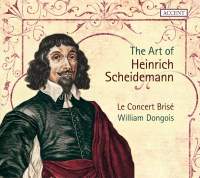 Le Concert Brisé: The Art of Heinrich Scheidemann. Accent Records (24302), 2016.
Le Concert Brisé: The Art of Heinrich Scheidemann. Accent Records (24302), 2016.
William Dongois, cornetto; Alice Julien-Laferriére, violin; Odile Bernard, recorder; Jean-Christophe Leciere, organ. Straight Cornetti by Henri Gohin in 3 parts pitched at 440 (tracks 3, 4, 5, 7, 14) and at 495 (tracks 2, 10, 12); Organ after Italian original, by Rudi Jacques, Talange, France.
Recorded at the church, Jésus Ouvrier, Talange, France, October, 2014 in A=440 at ¼ comma meantone.
Heinrich Scheidemann (1596–1663) first studied organ under his father, David, in his hometown of Hamburg and was sent by him to Amsterdam to study with Jan Pieterszoon Sweelinck from 1611-1614. Sweelinck dedicated his canon Ter eeren Of Vromen Jongkmans Henderich Scheijtman, van Hamborgk to him. Scheidemann succeeded his father as organist at St. Catherine’s in Hamburg and also was a consultant for organ building in Lübeck. His compositions are characterized by their improvisatory character and make great technical demands on the performer. At the same time, they are not merely vehicles for virtuosity. To be sure, there is substance in his compositions and a wide variety of moods are expressed.
Le Concert Brisé brings all of these qualities to light on this recording. Before singling out specific tracks and performers, I would like to say that several things in general stand out. First would be that the players blend beautifully with one another. With this combination of instruments, it would be very possible to produce a shrill sound, given their treble registers. This is not the case. The listener will be impressed and comforted by the smooth richness of sound, without a hint of edge. Second, please take note of the perfectly matched captivating articulation employed by all of the players. Third, note the refined shaping of phrases.
Surrexit pastor bonus (The Good Shepherd) is a beautiful piece which, to my ears, depicts the story of Jesus leaving the ninety-nine to look for the one lost sheep. The piece begins slowly in a low register for organ and cornetto: the discovery that a sheep is missing. The piece proceeds with sounds of concern for poor sheep: lost and defenseless. Things intensify as the search is carried out. It’s as though organ and cornetto are calling, “Where are you?.” This seems to peak mid-way when the cornetto executes passage which culminate on a high note while the organ works its way lower and lower in register. They are looking “high and low”! Then the mood changes as it would seem that they hear the lost sheep and call back to it. The piece concludes joyously with the reunion of sheep and shepherd. Listeners may disagree with this reviewer’s application of tonal painting to the piece, but I am confident you will find the performance to be captivating. Dongois plays with reverence and his technical displays are always with the highest refinement.
Earlier I mentioned how well the ensemble plays as a unit in every way. I must mention, however, that each of the individuals offers virtuosic performances which demand your attention. Specifically these would be Alice Julien-Laferriére’s violin work on Verbum caro factum est (after Orlando di Lasso), Odile Bernard’s performance on recorder of Pavanne lachrymae (after John Dowland), and Jean-Christophe Leciere’s performance on organ of the Praeambulum in D and specially, the Fuga in D. I have already mentioned the brilliant virtuosity of William Dongois, but would like to draw attention to the numerous extended passage which demonstrate not only his amazing technique, but also his great breath-control ---again, always being led by refined phrasing.
All in all, this CD by Le Concert Brisé is masterful. It is wonderful combination of Scheidemann’s music performed with brilliant virtuosity always informed by grace, and elegance. Special attention should be given to the arrangements from the original organ music by Dongois, as well as to this magnificent organ by Rudi Jacques. Once again, William Dongois combines creative and intriguing programming with performances which inspire the listener in every way.
-- James Miller



